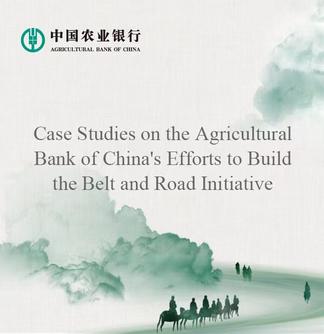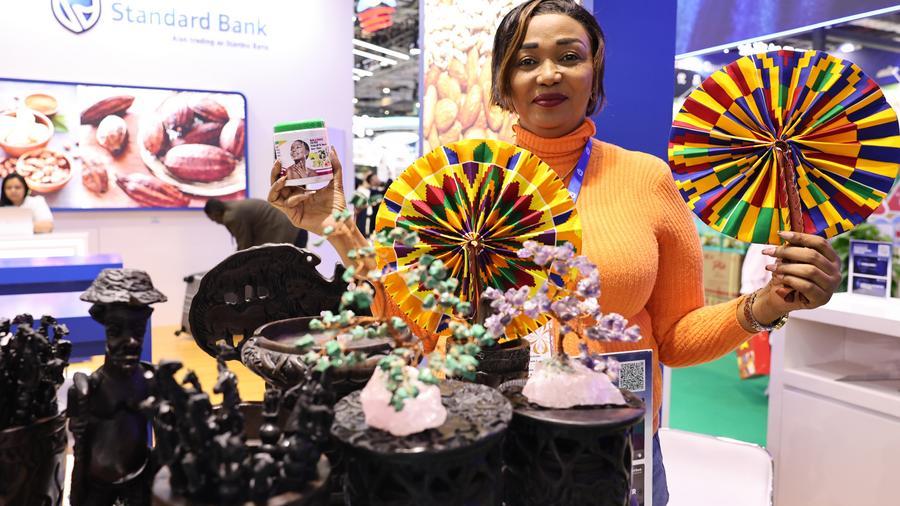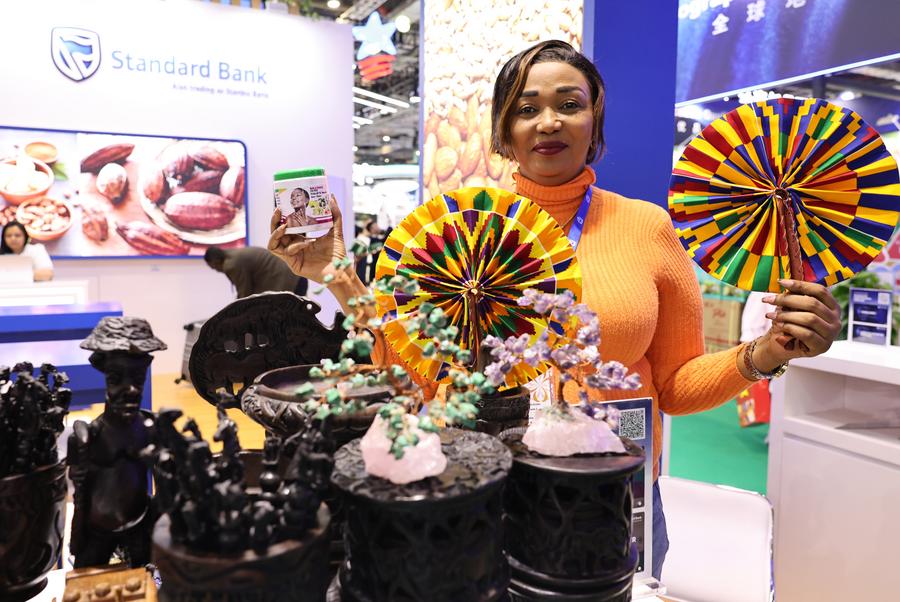
An exhibitor shows fans and moisturizing lotion from Ghana at the Food and Agricultural Products exhibition area during the eighth China International Import Expo in east China's Shanghai, Nov. 7, 2025. (Xinhua/Fang Zhe)
SHANGHAI, Nov. 9 (Xinhua) -- Eziz Sabirov is promoting honey via his limited Mandarin at the China International Import Expo (CIIE). This is the third time he has come to Shanghai for the event, but this year is notably different, with Kyrgyzstan having set up its own national pavilion for the first time.
The young man, who brought only white honey to the CIIE at first, showcased a variety of products this time around, including a type of honey which can relieve headaches and insomnia, while also promoting blood circulation.
"The CIIE changed the honey trade of Kyrgyzstan," Sabirov told Xinhua.
Honey featuring a variety of flavors, originally mainly sold in the domestic market, is now being regularly transported by China-Europe freight trains from Bishkek in Kyrgyzstan to Horgos in northwest China's Xinjiang Uygur Autonomous Region -- a key gateway connecting China with Central Asia and Europe.
"The CIIE has boosted the popularity of our honey products in China and created more opportunities for Kyrgyz beekeepers," Sabirov said. He also noted that national pavilions of different countries at the CIIE have ended up offering more business opportunities for small and developing countries.
"Near our booth, we can see not only European trading powers like France and Italy, but also countries from Central Asia, Africa and Latin America. Here we feel a fair, open and friendly business environment."
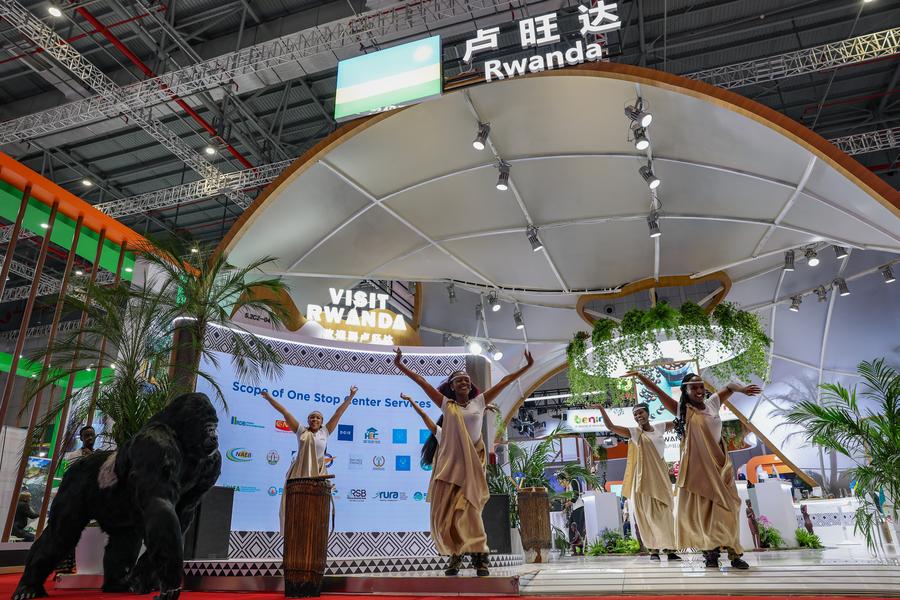
Actors perform dance at the Rwanda Pavilion of the eighth China International Import Expo (CIIE) in east China's Shanghai, Nov. 5, 2025. (Xinhua/Wang Zecong)
CIIE is the world's first national-level exposition dedicated to imports. The 8th CIIE this year has set a new record in terms of scale. It boasts participation from 155 countries, regions and international organizations -- with 4,108 overseas exhibitors and a total exhibition area of over 430,000 square meters, according to the Ministry of Commerce.
Sabirov is one of many to have benefited from this iconic Shanghai event.
A Bangladeshi couple have brought jute handicrafts from their hometown to the CIIE each year since 2018. Through this platform they have expanded their market, and their company now provides job opportunities for more than 3,000 local women.
Today at the expo, booths from multiple African countries are adorned with displays of local landscapes and traditional attire. Staff members at many of these booths beat lively drums and dance cheerfully to welcome visitors.
"At previous expos, product displays from some African countries were relatively simple -- mostly very 'rustic' agricultural goods. But this year, many African booths are eye-catching, with more design-oriented exhibits. It feels like visiting a 'boutique supermarket'," said Wang Xin, a frequent visitor to the CIIE for several years. Wang noted that more artistic booth designs and increasingly refined packaging serve as embodiment of the transformation of African exhibitors.
Li Guoqing, deputy director-general of the CIIE Bureau, said in an interview with Xinhua that they are expanding unilateral market access for the world's least developed countries (LDCs).
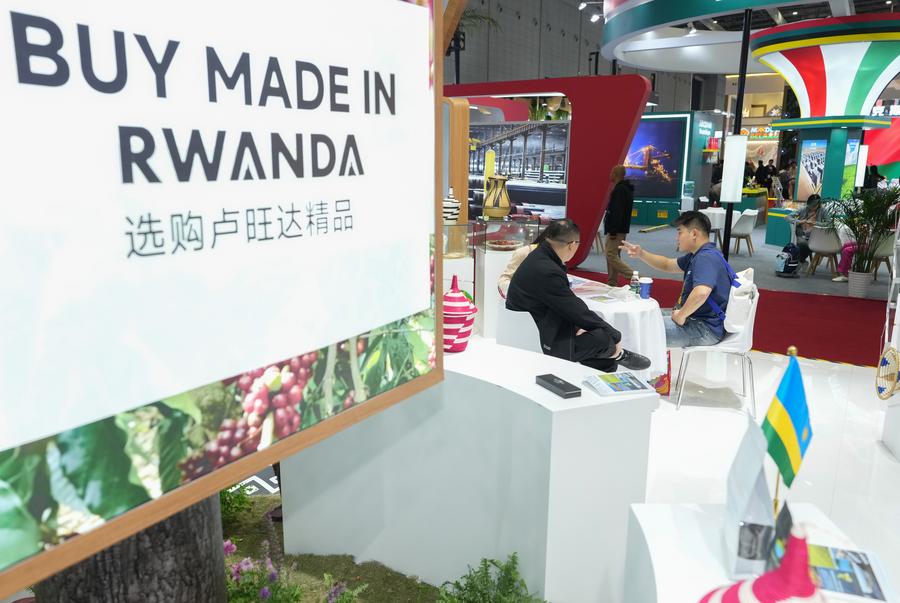
People talk at the pavilion of Rwanda during the 8th China International Import Expo (CIIE) in east China's Shanghai, Nov. 7, 2025. (Xinhua/Ren Pengfei)
This year's CIIE has, for the first time, set up a dedicated zone for products from these LDCs. Over 160 enterprises from 37 LDCs are participating in the eighth CIIE -- up 23.5 percent year on year.
At the Benin booth, visitors wait in long queues at the tasting area for "cream pineapples," curious about both their elongated shape and milky-white flesh. At the Togo booth, meanwhile, exhibitors showcased colorful fans, musical instruments and other handicrafts. Uganda's coffee and chili peppers also attracted many, with some stopping and talking business.
Andrew Gatera, a businessman from Rwanda attending the CIIE for the third time, said that each participation brings new experiences and connects him with more Chinese traders, laying a foundation for the expansion of Rwandan coffee in China. He noted that strong China-Rwanda bilateral relations and China's zero-tariff policy for African countries have proved favorable in facilitating the entry of his company's coffee into the Chinese market.
Clearly, the CIIE is serving as an effective window showcasing China's collaboration with LDCs.
Last year China announced that it would give all LDCs that have diplomatic relations with China, including 33 African countries, zero-tariff treatment for 100 percent tariff lines. This year China decided to extend zero-tariff treatment to 100 percent of tariff lines for 53 African countries with which it has diplomatic relations.
"Today, protectionism and de-globalization are spreading in some developed countries. In contrast, the CIIE, which centers on imports, provides a vast platform for the world," said Wang Wen, dean of Chongyang Institute for Financial Studies at the Renmin University of China.
"China's development and opening up offsets external uncertainties and makes its super-large market a global opportunity," he added.




 A single purchase
A single purchase

